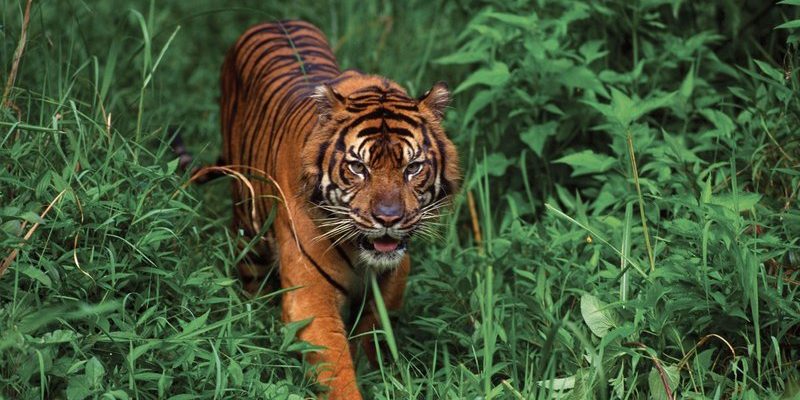
Tigers embody the spirit of their environment, acting as apex predators. This means they sit at the top of the food chain, governing the populations of their prey and, in turn, impacting the health of the entire ecosystem. So, let’s explore how these magnificent beings contribute to their habitats—like the glue that holds everything together in a bustling ecosystem.
The Role of Tigers as Apex Predators
Tigers primarily hunt large herbivores like deer and wild boar. This predatory role is vital for several reasons. Firstly, by controlling the populations of these herbivores, tigers help maintain a balanced ecosystem. If deer populations were left unchecked, they could overgraze vegetation, leading to habitat degradation for other species. In essence, tigers help keep the plant life healthy, which is the foundation of any ecosystem.
Here’s the thing: a healthy plant community provides food and shelter for various animals, insects, and even microorganisms. These plants can also affect soil quality and water retention in the environment. So when tigers hunt, they aren’t just targeting prey for food; they’re helping to ensure that the entire ecosystem thrives.
Moreover, as apex predators, tigers are often viewed as indicators of ecosystem health. When tiger numbers dwindle, it signals that something is wrong. This may be due to habitat loss, poaching, or other environmental pressures. By keeping a close eye on tiger populations, conservationists can gauge the overall well-being of entire ecosystems.
Impact on Biodiversity
Tigers play a huge role in promoting biodiversity. Biodiversity refers to the variety of life in a particular ecosystem. When tigers control prey populations, they indirectly encourage a healthy range of species to coexist. Prey animals need a variety of plants to thrive, and when their numbers are kept in check, those plants have a chance to flourish.
Imagine a lush forest with plenty of berries, shrubs, and grasses available. This abundance attracts many creatures, from birds to insects. In this way, tigers help promote a rich and vibrant ecosystem that supports different life forms. On the flip side, when tiger populations decline, it can lead to an imbalance where certain prey species can dominate. This imbalance often results in a less diverse environment.
More biodiversity translates into healthier ecosystems, which are more resilient to change. You’ll find that ecosystems with rich biodiversity can better withstand environmental stressors, like diseases or climate change. Therefore, the presence of tigers is a strong indicator of a robust ecosystem.
Tigers and Their Habitat
Tigers are incredibly adaptable and can thrive in various habitats, from dense forests to grasslands and mangrove swamps. However, they require large territories to live comfortably. This need for space means that tigers are often seen as “keepers” of their habitats. When they roam, they help maintain the ecosystems they inhabit through their movements and hunting patterns.
Consider a tiger’s territory as a well-designed park; it has specific areas for hunting, resting, and raising cubs. When tigers move through these zones, they have a way of keeping other wildlife in check. Each time they hunt, they create opportunities for smaller predators and scavengers. They allow for a dynamic environment that supports an array of wildlife.
The loss of tiger habitats due to deforestation, urban development, and climate change poses a significant threat not just to tigers, but to all species that depend on these ecosystems. When tiger habitats diminish, the intricate web of interdependence among species begins to unravel. Thus, protecting tiger habitats is crucial for maintaining the health of the overall ecosystem.
Tigers as Cultural Symbols
Beyond their ecological role, tigers symbolize strength, beauty, and even mystery in various cultures. They are often depicted in art and folklore, embodying the spirit of wilderness. This cultural significance can also be harnessed for conservation efforts. By fostering a connection between people and tigers, we can inspire a love for nature and motivate communities to protect these magnificent creatures.
Many programs use the tiger as a flagship species for conservation. By focusing on saving tigers, we inadvertently protect a wealth of other species and entire ecosystems. It’s a win-win situation—when people value tigers, they become more invested in preserving the environment where these tigers roam.
In some areas, ecotourism centered around tigers helps local economies thrive while promoting conservation. Travelers come from all over the world to catch a glimpse of these incredible animals in their natural habitats, providing communities with sustainable income that helps protect not just tigers but all forms of wildlife.
Threats to Tiger Populations
Despite their vital role, tigers face numerous threats. Habitat loss is one of the biggest challenges, largely driven by human activities like logging and agriculture. As their habitats shrink, tigers have fewer places to live and hunt, which can lead to declining populations.
Poaching for tiger parts, like bones and skin, also poses a serious threat. Unfortunately, some cultures believe that tiger parts have medicinal properties. This demand leads to illegal hunting, further endangering their numbers. Every time a tiger is poached, the ripple effects impact the entire ecosystem, potentially leading to the kind of imbalance we discussed earlier.
Conservation efforts are crucial in addressing these threats. Protected areas, anti-poaching laws, and community engagement can all contribute to saving tigers and, by extension, their habitats. Supporting organizations dedicated to wildlife conservation can make a significant impact.
Conservation Efforts and the Future
The future of tigers depends heavily on conservation efforts. Various organizations work to protect these big cats and their habitats, from creating wildlife reserves to promoting eco-friendly practices. These efforts aim not only to save tigers but also to ensure that the ecosystems on which all species depend remain intact.
Community involvement is essential. Local populations play a critical role in protecting tigers. When communities recognize the value of tigers, they’re more likely to take action to protect them. Education is key here; teaching people about the importance of tigers can transform attitudes toward conservation.
International collaboration is also crucial. Tigers roam across borders, so conservation efforts must be coordinated globally. Programs that focus on habitat protection, anti-poaching initiatives, and community engagement can help to maintain tiger populations and promote biodiversity.
In summary, tigers are more than just beautiful creatures; they are integral to the health of their ecosystems. By understanding their role and supporting conservation efforts, we can help ensure these magnificent animals continue to thrive for generations to come.

